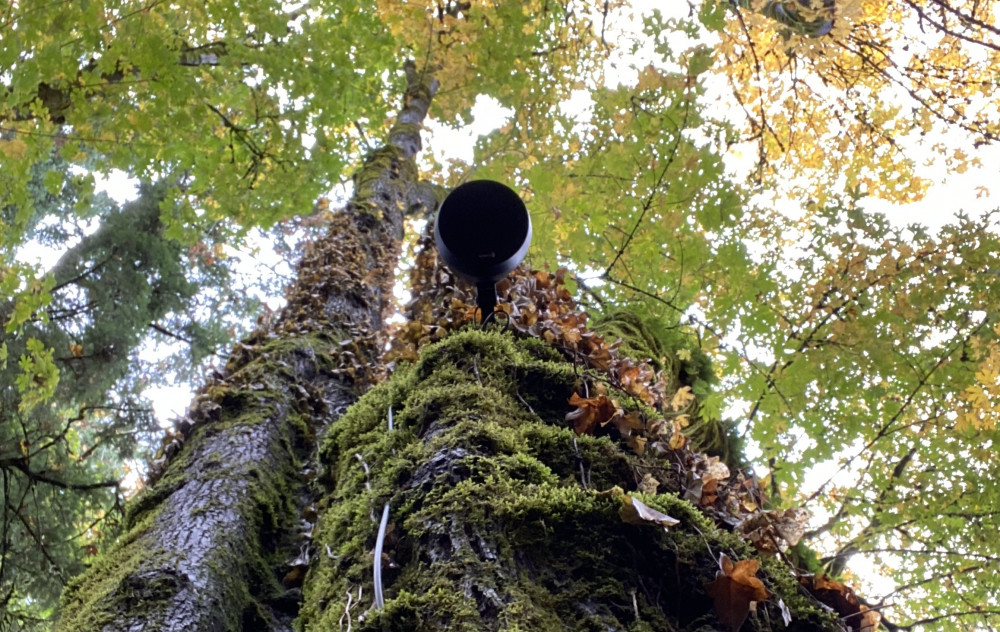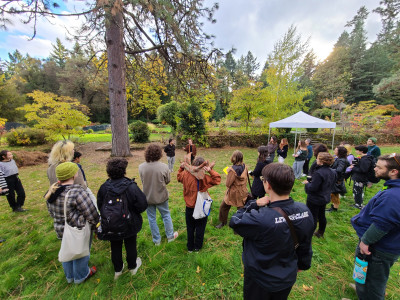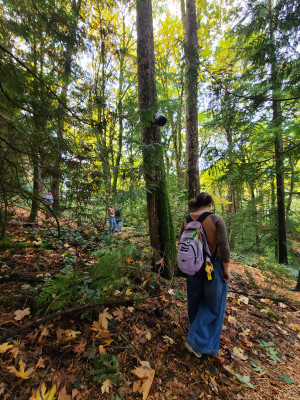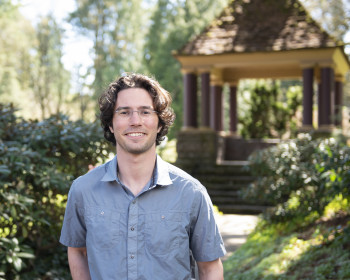Making (Sound) Waves in the EAR Forest
Lewis & Clark’s new Experimental Art Research (EAR) Forest is a space where professors, students, and visiting artists can create sound walks, auditory experiences, storytelling, musical compositions, and more!

Credit: Amy Drill
by Gabe Korer BA ’23
On a winding path amid tall fir trees, Lewis & Clark students and visitors now have the opportunity to experience a variety of sound-based programming via the Experimental Art Research (EAR) Forest.
The EAR Forest, which consists of an array of 16-channel speakers located behind the Fred W. Fields Center for the Visual Arts, was created by the art department through the receipt of a four-year, $500,000 grant from an anonymous foundation. The EAR Forest is envisioned as a space where L&C professors, students, and visiting artists can create sound walks, auditory experiences, storytelling, musical compositions, and more through scheduled programming.
As the project develops, creators will have the opportunity to incorporate the sound system into classes and events, allowing for dynamic soundworks and cross-disciplinary collaborations.
Jess Perlitz, associate professor of art, and Dann Disciglio, visiting professor of art/digital media, are leading the effort to conceptualize and execute the EAR Forest at Lewis & Clark.
“We’re interested in exploring how we can use the arts and technology to be more present and aware of the world we’re in,” Perlitz said. “There’s something about sound that makes people particularly attuned to their surroundings.”
First Event: Sonic Growth
The first exhibition in the EAR Forest, held on November 2, was titled Sonic Growth: Re-Imagining the Recognizable. The exhibition, curated by Isha Elboctorcy BA ’24 and Grayson Smith BA ’25, featured seven sound pieces created by students in Disciglio’s Digital Media II course. These pieces included both natural and synthesized sounds, with an emphasis on joining sound art with nature.

Credit: Stephen Mercier“The students used a Digital Audio Workstation (known colloquially as a DAW) to compose the pieces,” Disciglio said. “They were made mostly using digital field recordings that the students captured themselves.”
The compositions featured a wide array of emotions, and were created by the students with different goals in mind. One piece, titled “304 Countrywood,” used a crackling fire and muffled voices to create a comfortable atmosphere. Another, titled “Tread With Care,” sought to acknowledge human disturbances in environmental spaces by using human footsteps to transmit the message of “tread with care” in morse code.
“Each piece was so different,” cocurator Elboctorcy said. “Some were creepy, some tranquil, and others you could dance to. Being surrounded by human made sound along with nature was beautiful.”
In reflecting on the event, Disciglio says the goal was to use technology in a way that could tie people into their surroundings and senses. It is the hope of Perlitz and Disciglio that the EAR Forest can continue to be used for ecologically driven purposes during future pre-planned events.
“It’s important to be more aware—and more mindful—of our surroundings,” Disciglio said. “That’s our hope overall—to not just serve as a space for research and for collaboration, but to have those activities pay off in terms of increasing our understanding of our surroundings and enhancing our relationship to the world outside of us. And what a beautiful place to do that … on the Lewis & Clark campus that’s tucked in the woods.”
Growth in the Digital Arts
Funding for the EAR Forest is intended to further collaboration and innovation through art and technology. According to Perlitz, the grant has not only been instrumental in helping this project come to fruition, but also in furthering digital media’s reach within the arts at L&C.

Credit: Stephen Mercier“Digital media as an area of study is relatively new for us at Lewis & Clark,” Perlitz said. “So a grant like this not only allows us to get a lot of equipment that helps digital media, but also really allows us to collaborate, to create a system or situation where we can bring in other departments across the arts and use technology as a way to bring us together.”
Moving forward, Perlitz and Disciglio are planning to offer other faculty members mini grants in order for the Ear Forest to be incorporated into their classes, with the hope of expanding the project’s reach to other disciplines.
In addition, three artists-in-residence will be featured each academic year over the course of the grant, with the first set to arrive in spring 2024. The goal, says Disciglio, is to foster community interaction by bringing in a diverse group of artists to interact with the EAR Forest space.
“We’re using the artist-in-residency framework to see how the space can be activated,” Disciglio said. “Our hope is that we will be surprised by how artists conceive of the space. Overall, the emphasis is really on cross-departmental collaboration—extending beyond the arts, through the arts, and sometimes even against the arts—to envision all the ways that the EAR Forest can work for everyone in the community.”
Funding from the grant is also enabling Lewis & Clark to expand its technology resources. In addition to the recently installed forest sound system, the project includes funding for a new surround-sound recording studio, an archive of forest sounds for creative projects, augmented reality headsets, and an outdoor projection screen attached to Fields Center for the Visual Arts.
“This equipment presents us with an almost infinite number of possibilities,” Perlitz said. “We look forward to expanding the project to others in the Lewis & Clark community.”
More Newsroom Stories
Public Relations is located in McAfee on the Undergraduate Campus.
MSC: 19
email public@lclark.edu
voice 503-768-7970
Public Relations
Lewis & Clark
615 S. Palatine Hill Road MSC 19
Portland OR 97219

